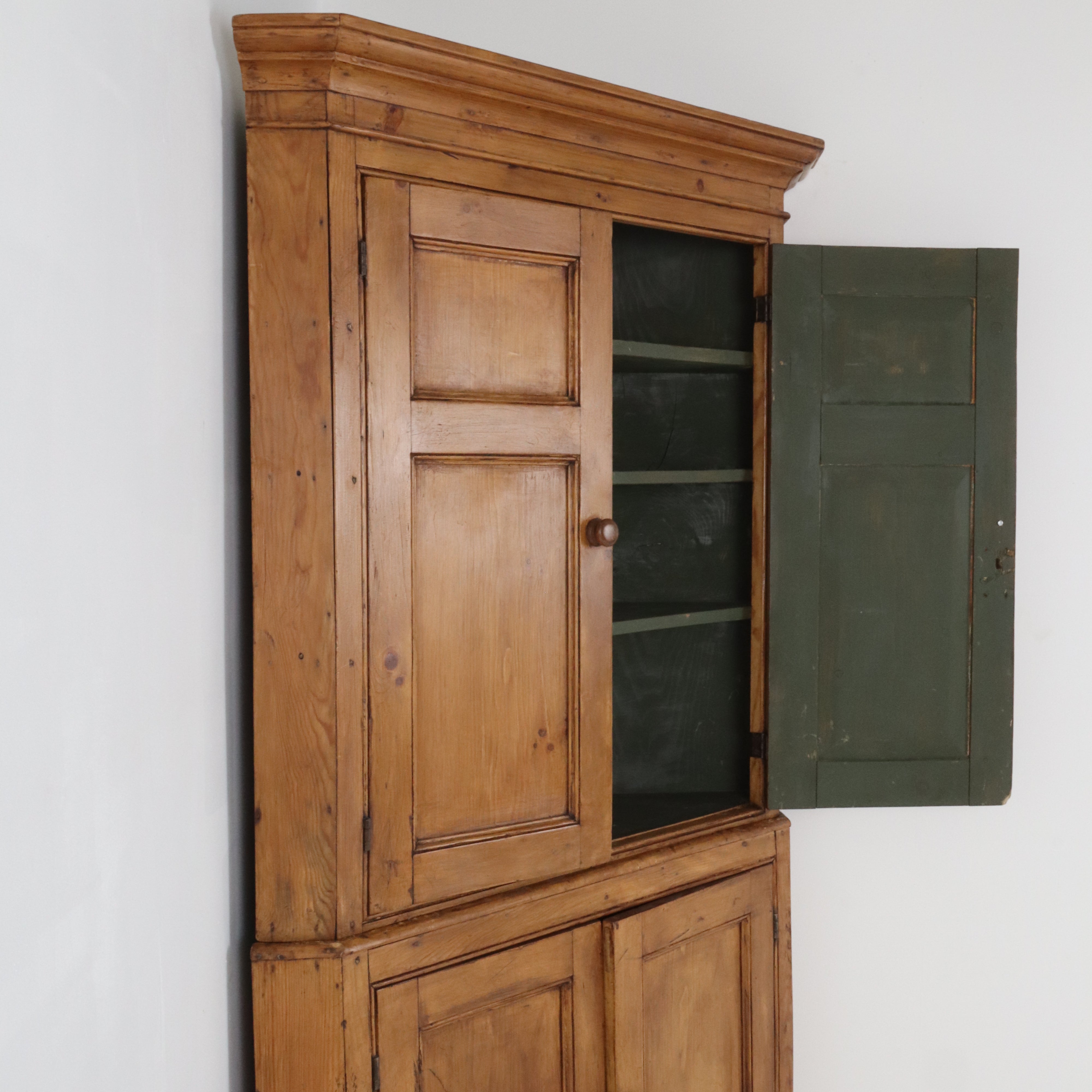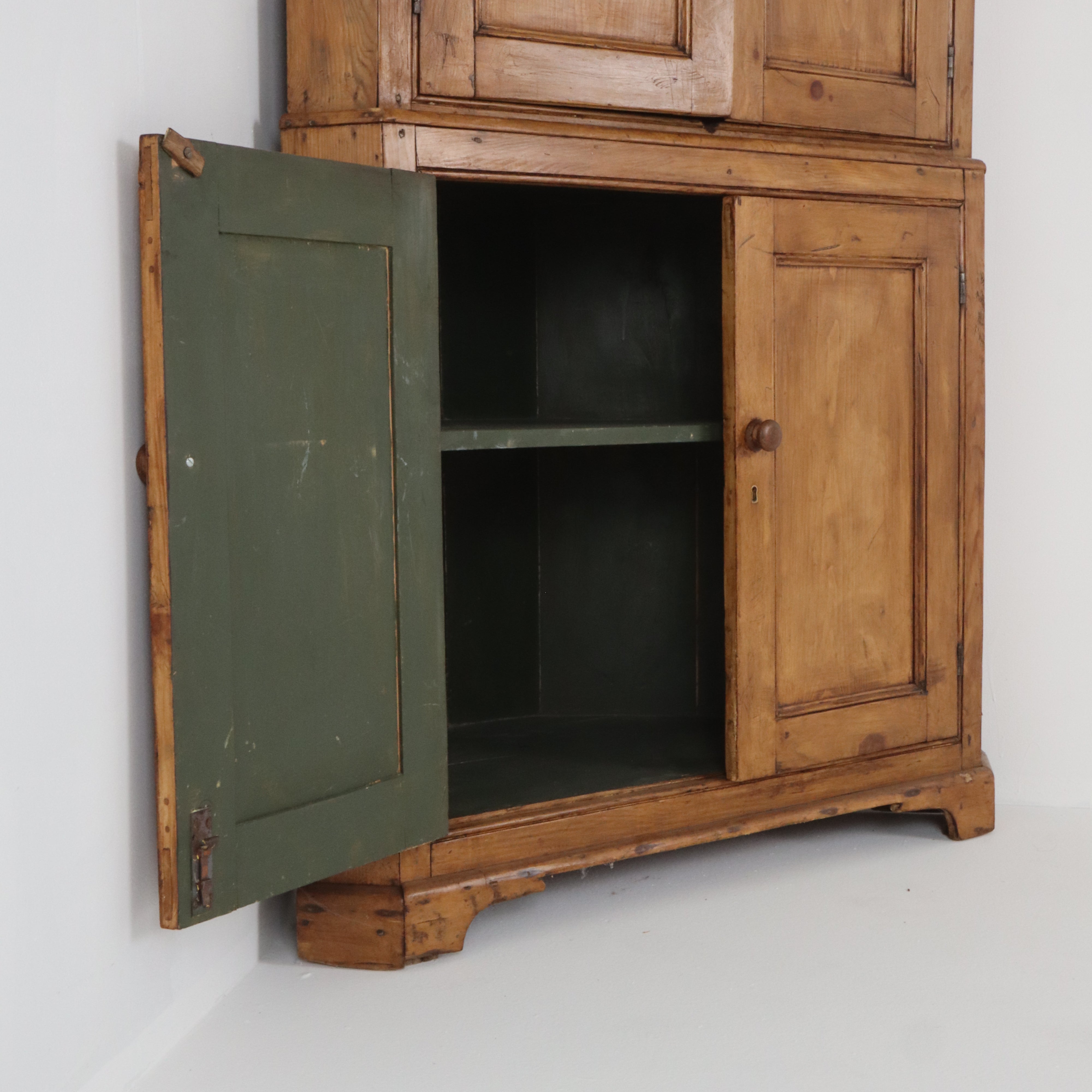Historical Context of Antique Pine Corner Cabinets

Pine, readily available and relatively inexpensive, played a significant role in the evolution of corner cabinet design throughout history. Its affordability made it accessible to a wider range of consumers, influencing the styles and construction techniques employed across various periods and regions. The versatility of pine, its ability to be stained and finished in diverse ways, further contributed to its popularity in cabinet making.
Evolution of Corner Cabinet Design and Pine Wood Usage
The use of pine in corner cabinet construction reflects broader trends in furniture making. Early examples, often found in rural areas, were simpler in design, utilizing basic joinery techniques and minimal ornamentation. As woodworking techniques advanced and styles evolved, pine corner cabinets became more elaborate, incorporating decorative elements such as carvings, moldings, and painted finishes. The availability of pine influenced the size and scale of these cabinets; larger, more ambitious pieces were possible due to the material’s abundance. The transition from purely functional storage to incorporating aesthetic considerations is evident in the evolution of these cabinets.
Craftsmanship Techniques in Different Eras
Early corner cabinets, often dating back to the 18th and 19th centuries, demonstrate a focus on robust construction. Techniques like mortise and tenon joinery, dovetail joints, and peg construction were prevalent, ensuring durability and longevity. These methods, often hand-executed, showcase the skill of the craftsman. Later periods saw the incorporation of more intricate joinery, alongside the use of metal hardware and decorative elements. The introduction of mass-production techniques in the 20th century led to a shift towards simpler designs and less elaborate joinery, though some manufacturers continued to produce high-quality pieces using traditional methods.
Regional and National Style Variations in Antique Pine Corner Cabinets
Significant variations in style exist across different regions and countries. American colonial-era pine corner cabinets often featured simpler lines and a focus on functionality, while those from the Victorian era might incorporate more elaborate ornamentation and decorative elements. European examples, particularly those from Scandinavia or the British Isles, may display unique characteristics influenced by local woodworking traditions and available resources. For example, Scandinavian pieces might emphasize clean lines and natural wood finishes, while British examples might show influences from various historical styles such as Georgian or Regency. These differences highlight the impact of cultural context and regional preferences on cabinet design.
Timeline of Significant Periods and Styles in Antique Pine Corner Cabinet Production
| Period | Style Characteristics | Notable Features | Geographic Origin |
|---|---|---|---|
| 1700-1780 (Colonial America) | Simple, functional design; plain surfaces; often painted | Solid construction; basic joinery; minimal ornamentation | American Colonies |
| 1780-1830 (Federal/Early American) | More refined lines; inlaid wood; classical influences | Elegant proportions; use of veneers; refined joinery | United States |
| 1830-1870 (Victorian Era) | Ornate details; carved embellishments; dark stains | Intricate carving; decorative hardware; elaborate moldings | United States, Europe |
| 1870-1920 (Arts & Crafts Movement) | Simple, handcrafted style; emphasis on natural wood grain | Honest construction; minimal ornamentation; focus on functionality | United States, Europe |
Identifying and Appraising Antique Pine Corner Cabinets

Appraising antique pine corner cabinets requires a keen eye for detail and a solid understanding of antique furniture construction and market trends. Distinguishing genuine antiques from reproductions demands careful examination of various features, from the wood itself to the construction methods employed. This process involves a blend of observation, research, and informed judgment.
Key Distinguishing Features of Genuine Antique Pine Corner Cabinets
Genuine antique pine corner cabinets possess characteristics that often elude reproductions. The age and history of the piece are reflected in subtle but significant ways. For instance, the wood itself will show signs of age, including variations in color, texture, and the presence of natural imperfections. These imperfections, unlike those deliberately added to mimic age, will appear natural and integrated within the wood’s grain. Furthermore, the joinery techniques used in antique construction often differ significantly from modern methods. Hand-cut dovetails, for example, are a hallmark of quality craftsmanship and are rarely replicated precisely in modern reproductions. Finally, the overall patina – the surface sheen and color developed over time – is difficult to replicate artificially and provides a strong indication of authenticity.
Identifying Common Markings, Stamps, and Construction Techniques
Identifying markings and stamps can provide crucial information about the origin and age of a cabinet. Look for maker’s marks, often stamped or hand-painted on the inside of the cabinet or on less visible areas. These marks can sometimes identify the cabinet maker, the region of origin, or even the approximate date of manufacture. Pay close attention to the joinery. Hand-cut dovetail joints, mortise and tenon joints, and other traditional methods are indicative of age and quality. Examine the wood for signs of hand-planing, which often leaves subtle but distinctive markings. Conversely, machine-made marks are a strong indicator of a later reproduction. The presence of old hardware, such as hand-forged hinges or latches, can also contribute to the cabinet’s authenticity. However, it’s important to note that replacement hardware can sometimes obscure the true age of a piece.
Assessing the Condition and Value of an Antique Pine Corner Cabinet
Assessing the condition is paramount in determining value. Examine the cabinet for any signs of damage, including cracks, repairs, or woodworm infestation. The extent of any damage significantly impacts the overall value. Consider the completeness of the cabinet. Are all parts original and intact? Missing or replaced components can significantly reduce value. The cabinet’s finish should also be assessed. Original finishes are highly valued, while repainted or heavily restored pieces generally command lower prices. Finally, market research is crucial. Consult auction records, antique dealer catalogs, and online resources to get an understanding of comparable pieces and their selling prices. Remember, condition, rarity, and provenance all contribute to a cabinet’s value.
Appraisal Checklist for Antique Pine Corner Cabinets
Before beginning an appraisal, it is important to gather as much information as possible about the piece. A systematic approach using a checklist will ensure a thorough assessment.
- Wood Type and Quality: Identify the type of pine (e.g., white pine, yellow pine). Assess the quality of the wood, noting any knots, imperfections, or unusual grain patterns. Document the presence of any significant wood defects.
- Age and Origin: Determine the approximate age using stylistic features, construction techniques, and any identifying marks or stamps. Research the potential origin of the cabinet based on its style and construction.
- Construction Techniques: Examine the joinery (dovetails, mortise and tenon, etc.) and note the level of craftsmanship. Identify any machine-made marks that might suggest a later reproduction.
- Condition: Assess the overall condition, noting any damage (cracks, repairs, woodworm infestation). Evaluate the finish (original, repainted, etc.) and the presence of any missing or replaced parts.
- Style and Design: Identify the cabinet’s style (e.g., Georgian, Victorian, Arts & Crafts). Note any unique design features or decorative elements.
- Hardware: Examine the hardware (hinges, latches, handles). Are they original? Are they of high quality? Document any markings or maker’s stamps on the hardware.
- Provenance: If possible, trace the cabinet’s history and ownership. A documented provenance significantly enhances value.
Caring for and Restoring Antique Pine Corner Cabinets

Owning an antique pine corner cabinet is akin to possessing a piece of history. Proper care and restoration are crucial not only to preserve its aesthetic beauty but also to maintain its historical value and ensure its longevity for generations to come. Understanding the specific needs of these cabinets allows for informed decisions in preservation and repair.
Cleaning and Maintaining Antique Pine Corner Cabinets
Regular cleaning is paramount in preventing the accumulation of dust, grime, and potentially damaging substances. A soft, dry cloth is often sufficient for routine dusting. For more thorough cleaning, a slightly damp (not wet) cloth with a mild, pH-neutral soap can be used, followed by immediate drying with a clean, soft cloth. Avoid harsh chemicals, abrasive cleaners, and excessive moisture, which can damage the wood and finish. Protecting the cabinet from direct sunlight and extreme temperature fluctuations is equally important to prevent cracking and warping. Regularly inspect the cabinet for any signs of damage or deterioration.
Common Problems with Antique Pine Corner Cabinets
Antique pine, like all wood, is susceptible to several issues over time. Wood rot, often caused by moisture exposure, can weaken the structure and lead to significant damage. Insect infestation, particularly from wood-boring beetles, can cause extensive internal damage, sometimes invisible until significant structural weakening occurs. Finish deterioration, manifested as cracking, chipping, or fading, affects the cabinet’s appearance and offers less protection against environmental factors. These problems require careful assessment and professional intervention in many cases.
Repairing Minor Damage to Antique Pine Corner Cabinets
Minor scratches and dents can often be addressed with wood filler matched to the cabinet’s color. Apply the filler sparingly, allow it to dry completely, and sand smooth. For more significant damage, such as cracks or broken pieces, professional intervention might be necessary. Repairing wood rot often requires specialized techniques and materials to replace compromised wood. Finish restoration might involve cleaning, applying a touch-up of the existing finish, or, for more extensive damage, re-finishing the entire piece. It is crucial to use products compatible with the original finish to avoid damaging the antique piece further.
Safely Moving and Transporting an Antique Pine Corner Cabinet
Before moving, a thorough inspection should be performed to assess the cabinet’s condition and identify any potential weak points. Padding and protection are vital to prevent damage during transit.
- Preparation: Disassemble any removable parts, such as shelves or drawers, and carefully wrap them in protective materials like bubble wrap or acid-free tissue paper.
- Padding: Wrap the entire cabinet in several layers of moving blankets or other thick padding. Pay particular attention to corners and edges, which are prone to damage.
- Securing: Use straps or rope to secure the padded cabinet to a sturdy base, such as a moving dolly or a platform. Ensure the cabinet is balanced and stable.
- Transportation: Use a vehicle with adequate space and cushioning. Avoid sudden stops and jarring movements during transport.
- Handling: Always lift the cabinet using proper lifting techniques, avoiding twisting or jarring movements. Multiple people should assist with lifting and moving heavy pieces.
